
Retail inventory is more than just products on a shelf; it is your business's most critical financial asset and the core of your operational efficiency. For retailers in Saudi Arabia's fast-growing market, mismanaged inventory directly translates to lost sales during peak seasons, unhappy customers with high expectations, and capital tied up in stagnant stock that doesn't meet local demand.
With the Saudi retail sector expanding and consumer preferences evolving rapidly, having the right products, in the right quantities, at the right time is crucial for capitalizing on new opportunities. It is a necessity for competing effectively and achieving sustainable growth.
This guide will walk you through the essential methods, practical steps, and proven best practices for retail inventory management tailored to the regional context. You will learn how to move from reactive stock-keeping to proactive inventory control, turning this complex challenge into a key driver for your profitability and customer loyalty.
Retail inventory refers to all the goods and products a business holds for the ultimate purpose of sale to its customers. It includes every item across your stores, warehouses, and in transit. For your business, this inventory represents a major investment and is the direct link between your supply chain and your sales revenue.
Effective management of these goods is fundamental, as it determines your ability to meet customer demand, manage cash flow, and maintain profitability. Mismanagement can quickly lead to either excess stock that ties up capital or stockouts that result in lost sales and damaged customer trust.
Understanding the components of your inventory is the first step toward controlling it. Typically, this includes:
For most retailers, "finished goods" constitute the primary focus of inventory management. The goal is to maintain the optimal level of these goods to satisfy customer orders without incurring unnecessary holding costs.
Also read: The Ultimate Guide to Top Retail ERP Software Solutions
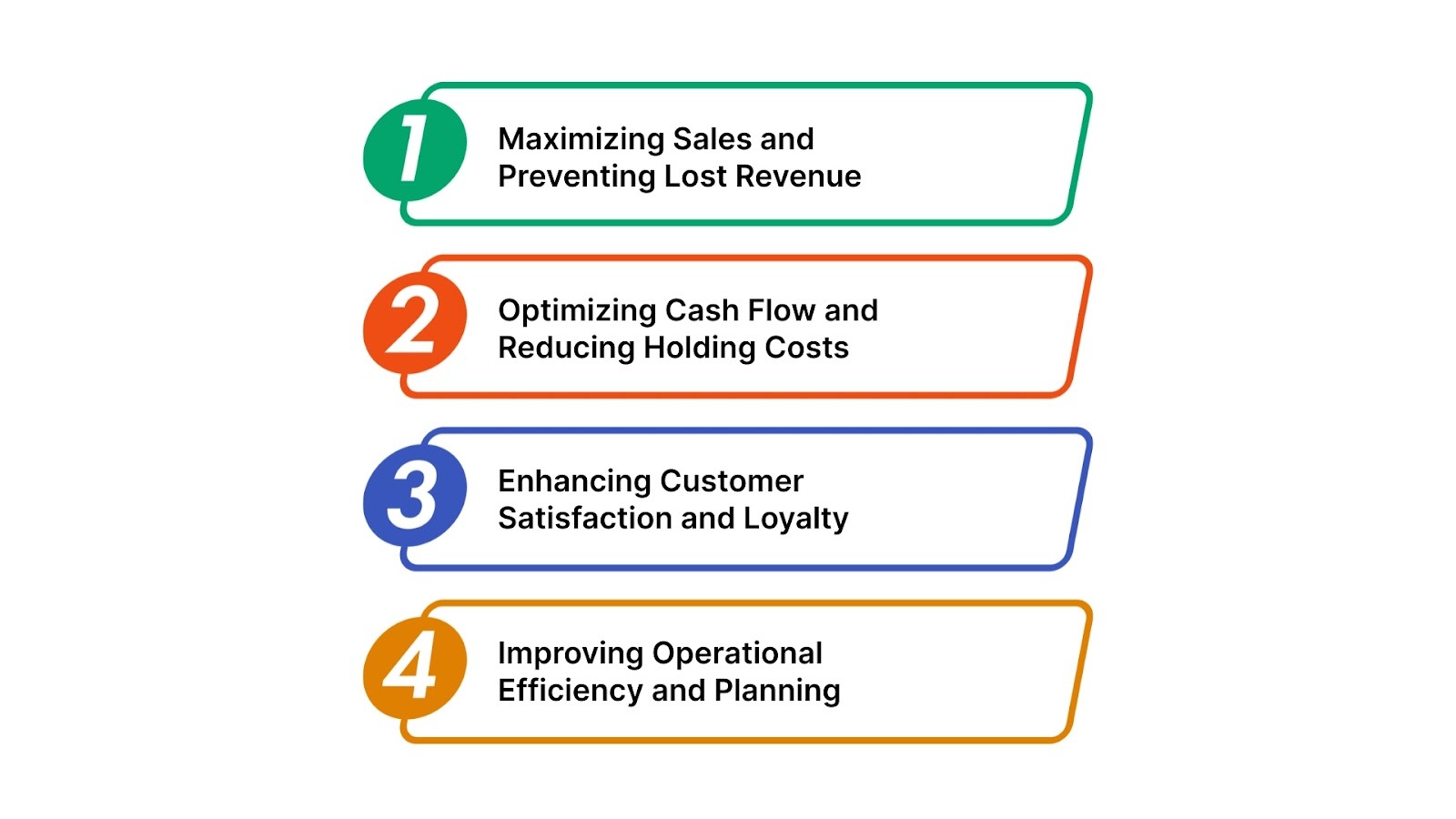
Effective retail inventory management is a strategic function. It goes far beyond simple stock counting. It is the central nervous system of a profitable retail operation.
This system directly influences your financial health and customer relationships. When you have clear control over your inventory, you can make informed decisions. These decisions drive sustainable business growth.
For businesses in Saudi Arabia, this mastery is key. It allows you to navigate the competitive local market and maximize profitability.
Conversely, poor practices lead to avoidable losses. They can also severely hinder your ability to scale your operations effectively. The importance of getting it right is clear across several key business areas:
Accurate inventory levels ensure products are available when and where customers want to buy them. This prevents stockouts that directly lead to lost sales and ensures you can capitalize on demand, especially during peak seasons or promotions.
Inventory represents capital that is sitting on your shelves. Effective management prevents overstocking, which frees up cash that can be used for other critical business investments. It also minimizes costs associated with storage, insurance, and potential obsolescence.
Customers expect to find the products they need. Reliable product availability builds trust and encourages repeat business. Furthermore, accurate inventory data prevents the frustration of selling an item that is out of stock, protecting your brand's reputation.
When your team has a well-organized inventory system, they waste less time tracking down items or fixing mistakes. This streamlines operations from receiving to sales, reduces labor costs, and provides reliable data for forecasting and strategic planning.
Also read: Best Accounting Software For Your Online Retail Business
Achieving these benefits requires a systematic approach, which begins with selecting the right inventory valuation method for your business.
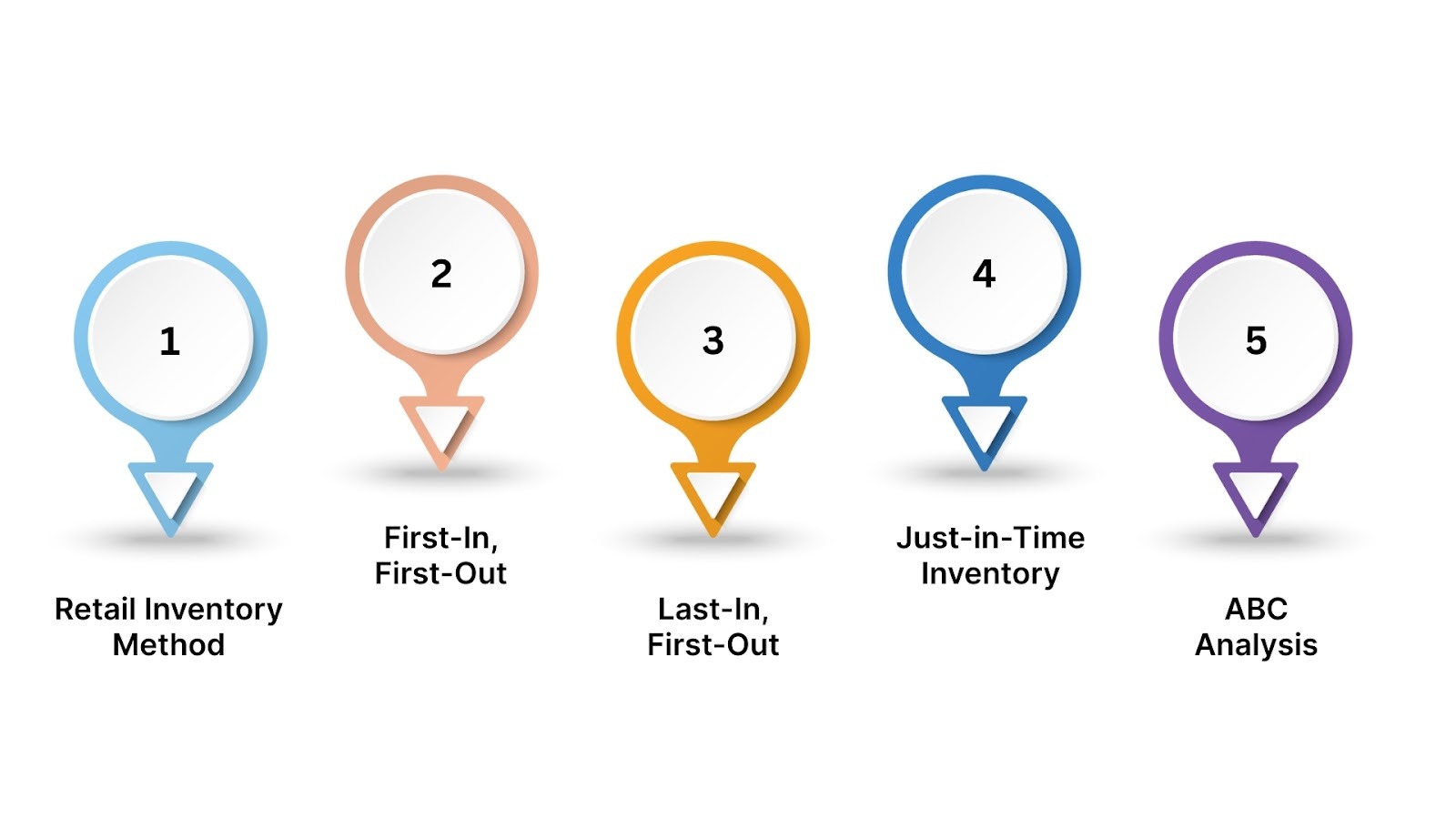
Selecting the right inventory management method is a critical decision that shapes how you track stock value, calculate costs, and report profitability. Each method has it's own benefits and is suited to different types of retail businesses, based on factors like product perishability, price volatility, and sales volume.
Understanding these core approaches allows you to choose the one that best aligns with your operational needs and financial reporting requirements. Whatever method you choose will affect your financial statements and decision-making. Here are the most common retail inventory management methods:
This method estimates the ending inventory value by using a cost-to-retail price ratio. It is widely used in the retail industry for its simplicity in providing a monthly estimate without a physical count, making it useful for financial reporting and insurance purposes. However, it is an estimate and may not account for specific item markdowns or shrinkage.
First in, first out assumes that the oldest inventory items are sold before the newer ones. This method is often preferred when product freshness or obsolescence is a concern, as it ensures older stock is cycled out. When inflation happens, FIFO usually leads to a lower cost of goods sold and a higher reported profit.
Under the LIFO method, the most recently acquired items are sold first. This approach can be helpful for tax purposes in some areas during inflation, as it can result in a higher cost of goods sold and lower net income, which may lower tax liability. It is less common for perishable goods.
The JIT method aims to receive goods from suppliers only as they are needed in the production process or for sale. This minimizes holding costs and reduces the risk of obsolescence but requires highly reliable suppliers and accurate demand forecasting to avoid disruptive stockouts.
This technique involves categorizing inventory into three classes: 'A' items (high-value, low-quantity), 'B' items (moderate-value, moderate-quantity), and 'C' items (low-value, high-quantity). It lets you focus management efforts and control strategies on the most important products, making sure resources are used efficiently.
Also read: A Complete Guide to Deferred Revenue and How to Record It
While these methods provide a financial framework, putting them into practice is often hindered by a set of common operational hurdles.
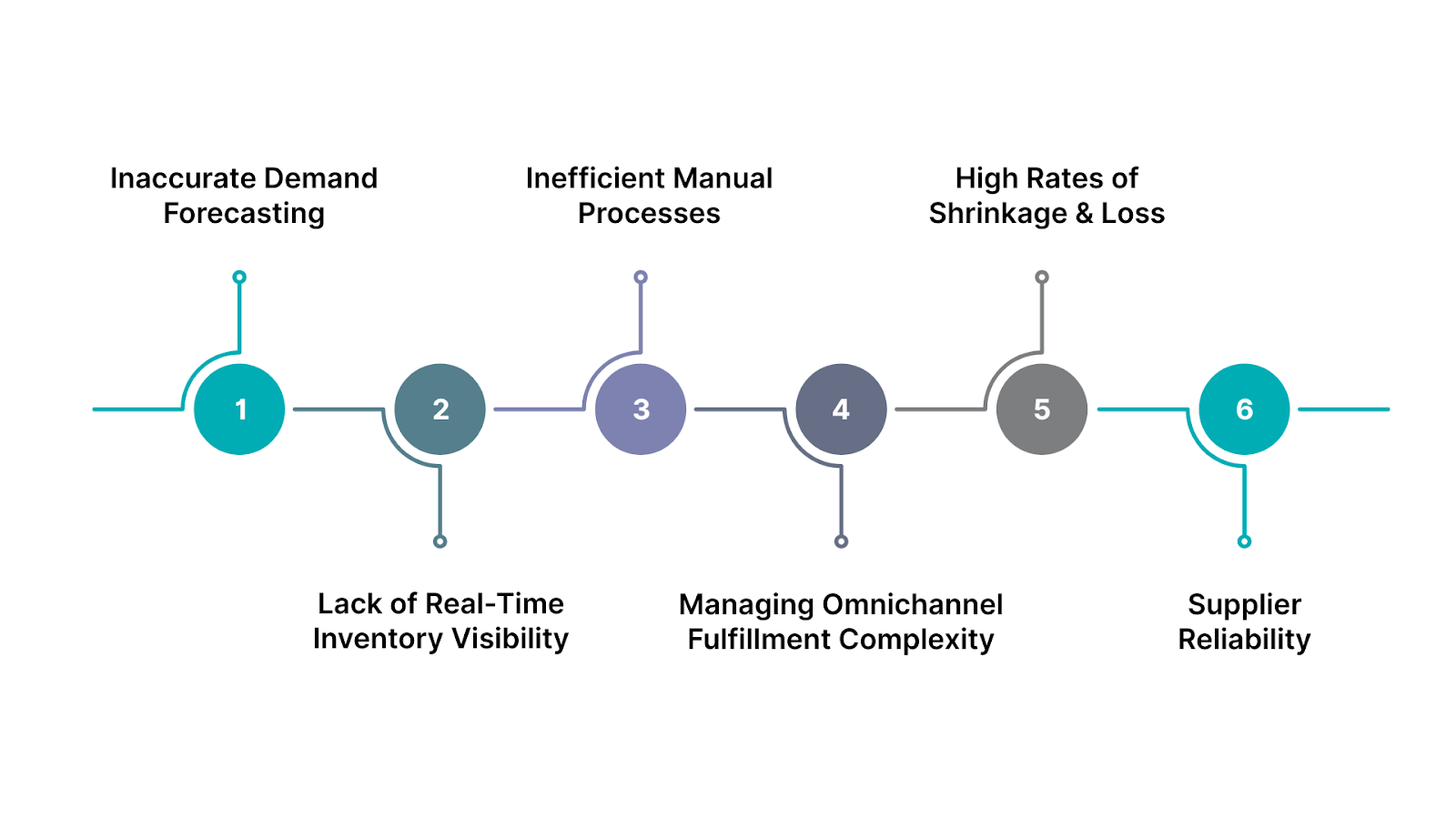
Even with the right methods in place, retail inventory management in Saudi Arabia presents a complex set of operational hurdles. These challenges often stem from disconnected systems, inaccurate data, and rapidly changing market conditions.
For growing businesses, these issues can escalate from minor inefficiencies into significant financial losses and damage to customer relationships. Recognizing these common obstacles is the first step toward building a more resilient and responsive inventory operation.
Many retailers encounter similar pain points that hinder efficiency:
These challenges are interconnected, often stemming from a lack of a unified system. Overcoming them is the first step toward sustainable growth. If you are struggling with these challenges, book a consultation with HAL to see how an integrated platform can provide the control you need.
Also read: Understanding the Basics of Supply Chain Management
Despite these challenges, maintaining accurate financial records is non-negotiable. Here is the fundamental step-by-step process for calculating your inventory value.
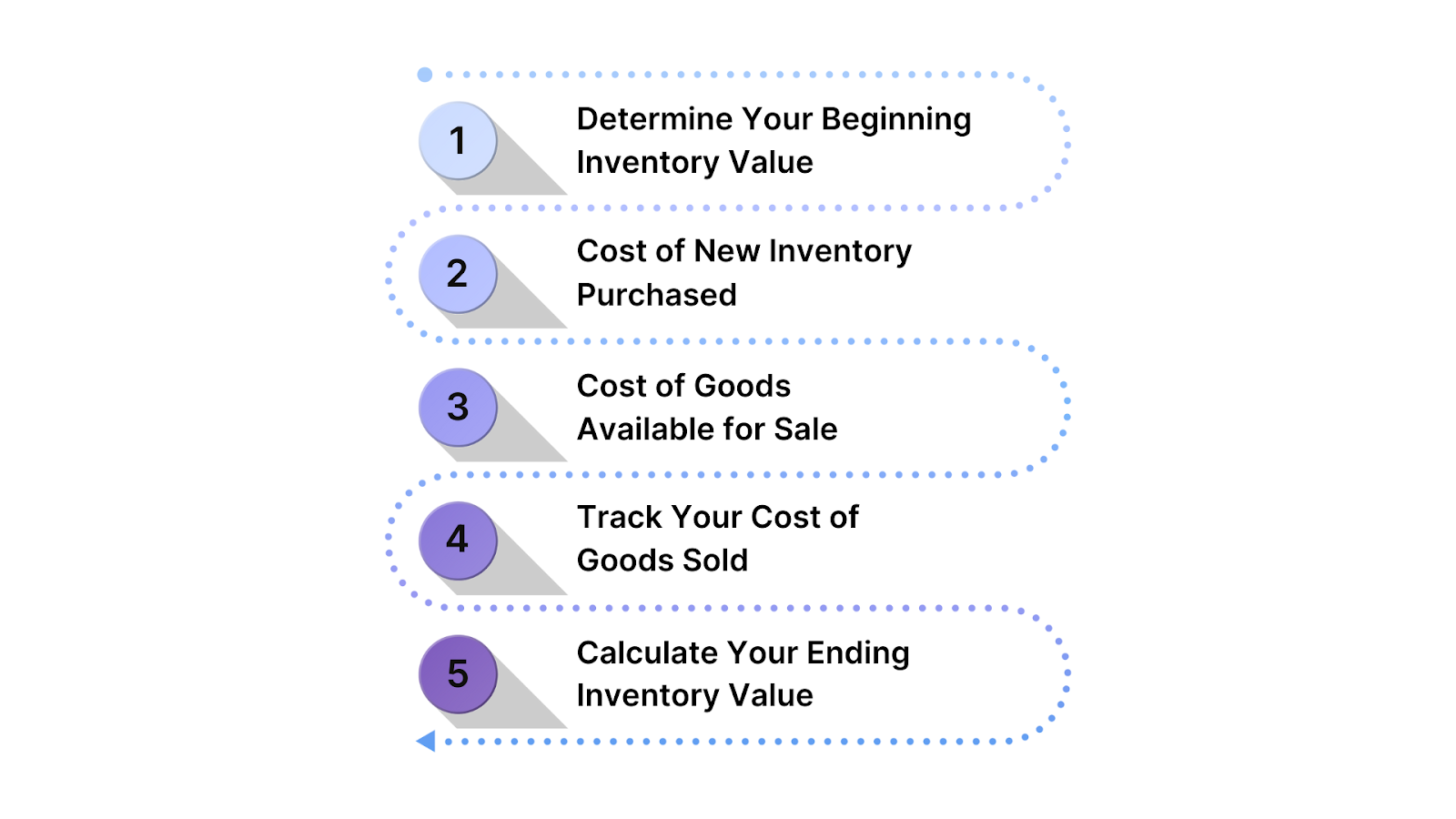
Accurate inventory calculation is essential for understanding your business's financial health, making informed restocking decisions, and preparing precise financial statements.
While methods like FIFO and LIFO are used for accounting valuation, the fundamental process of determining your physical inventory value remains consistent. This involves a clear, step-by-step approach to account for all goods available for sale during a specific period.
You can determine your ending inventory value by following this general process:
Start by establishing the total value of all inventory you had in stock at the beginning of the accounting period. This value should be directly taken from the ending inventory value of your previous period's records.
Next, calculate the total cost of all additional inventory purchased or manufactured during the current accounting period. This includes all goods acquired for sale, before any sales have occurred.
Add the value of your beginning inventory (from Step 1) to the cost of new purchases (from Step 2). This sum represents the total cost of all inventory that was available to be sold to customers during that period.
Calculate the total cost of the inventory that was actually sold to customers during the period. Here, you multiply the number of units sold by their original purchase or production cost, which can change depending on the inventory valuation method you use, such as FIFO or LIFO.
Subtract your Cost of Goods Sold (from Step 4) from the Cost of Goods Available for Sale (from Step 3). The result is the value of the inventory that remains unsold and on hand at the end of the accounting period. This figure is crucial for your balance sheet and for planning the next period's purchases.

Also read: How to Calculate Cost of Goods Sold (COGS) Effectively
Calculation provides a snapshot, but sustained control requires embedding ongoing best practices into your daily operations.
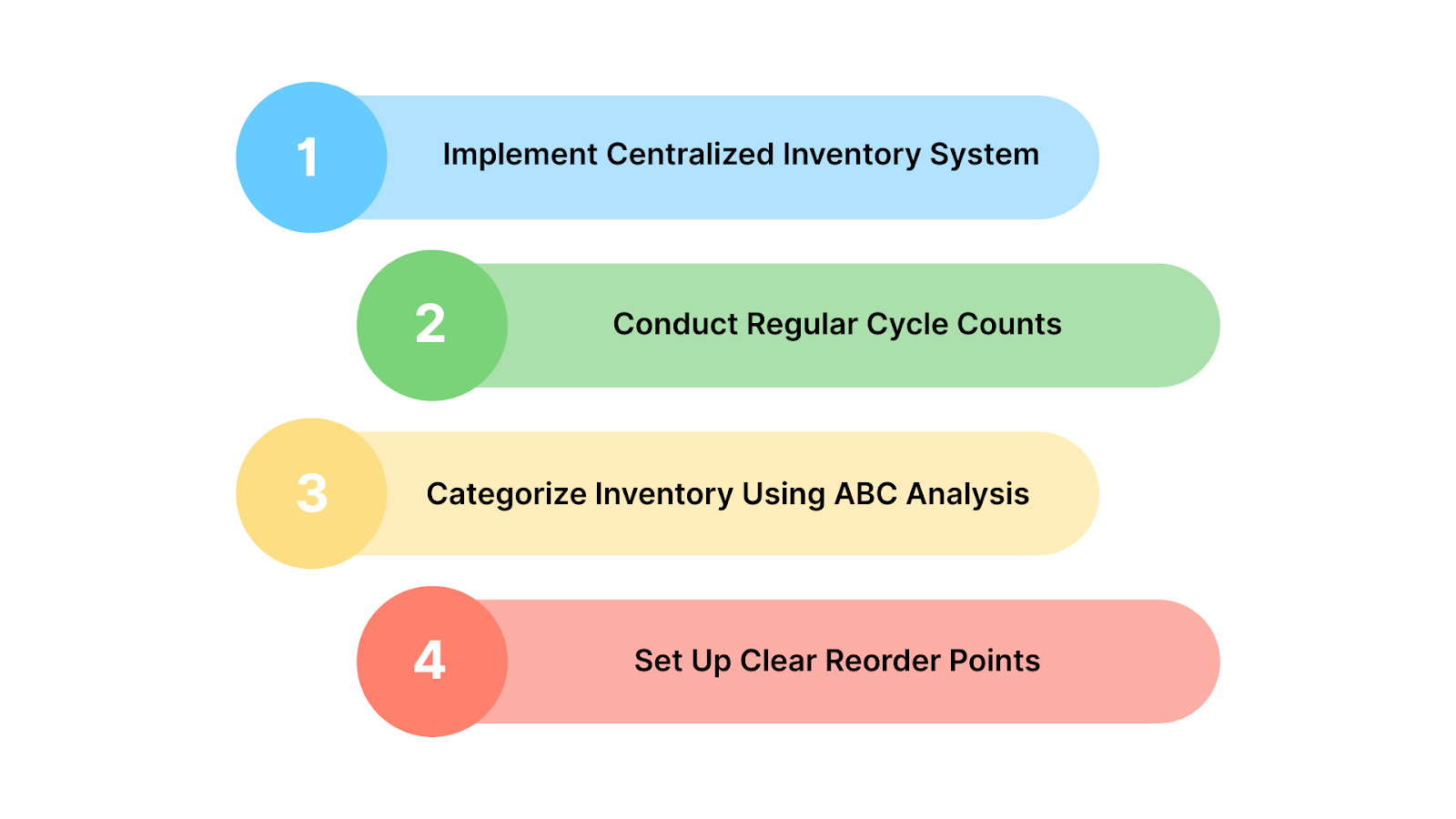
Moving beyond basic calculation, true retail stock control is achieved by implementing strategic operational practices. These best practices are designed to enhance accuracy, improve efficiency, and provide the data-driven insights needed for proactive decision-making.
For growing retailers, adopting these methods reduces costly errors, frees up team members for higher-value tasks, and creates a more responsive and profitable operation.
Integrating these core strategies into your daily routine can significantly improve your inventory control:
Using a unified software platform eliminates data silos between your sales channels, warehouse, and procurement. This provides a single, real-time view of stock levels across all locations, preventing overselling, improving order accuracy, and forming a reliable foundation for forecasting.
Instead of relying solely on disruptive full physical counts, schedule frequent, small counts of specific inventory categories. This continuous auditing process helps you identify and investigate discrepancies quickly, maintaining data accuracy without halting daily operations.
Group your inventory into three categories by value and sales velocity: A-items (high-priority), B-items (medium-priority), and C-items (low-priority). This allows you to focus your management efforts and resources on controlling the most impactful products, ensuring optimal stock levels for your top sellers.
For each key SKU, determine a predefined inventory level that triggers a new purchase order (reorder point) and a buffer quantity to protect against unexpected demand or supply delays (safety stock). This systematic approach prevents both stockouts and excessive ordering, ensuring operational continuity.
Implementing these best practices effectively demands a unified technological foundation. This is where a dedicated ERP system transforms theory into tangible results.


HAL ERP consolidates essential retail functions into a single platform, providing comprehensive control over multi-outlet operations. As a leading ERP for retail KSA, the system ensures efficient inventory tracking across all locations to maintain optimal stock levels.
It is built to support the specific needs of the Saudi market, including automated ZATCA e-invoicing compliance and accurate VAT reporting, ensuring your business adheres to local regulations without manual effort.
It enhances the customer experience through automated billing, flexible payment options including BNPL, and instant digital receipts. Built-in integrations with major payment gateways, e-commerce platforms, and loyalty programs work together to streamline operations from sales to fulfillment.
Also, the detailed analytics provide actionable insights for strategic decision-making.
Key features:
Al Homaidhi Group, a leading Saudi luxury retailer, partnered with HAL ERP to overcome legacy system limitations like slow sales reporting and fragmented pricing. HAL ERP delivered real-time insights, dynamic store-level pricing, seamless omnichannel operations, automated WhatsApp billing, and e-commerce integration.
With support for targeted promotions and detailed analytics, Al Homaidhi saw improved agility, increased profitability, and stronger customer satisfaction. The transformation included local training, smooth data migration, and integration with payment and online platforms, positioning the group for long-term retail success.
Ready to optimize your retail inventory? Schedule a free consultation with HAL ERP experts today.
Manual inventory processes and disconnected data create a constant risk of stockouts, overstocking, and inaccurate financial reporting. These challenges hinder growth and erode customer trust.
HAL Simplify addresses these issues directly by integrating your inventory, sales, and procurement into a single, automated platform. It gives you real-time visibility and data-driven tools to keep stock levels optimal, cut costs, and make informed decisions with confidence.
Q: What is the main advantage of the Retail Inventory Method (RIM)?
RIM provides a quick estimate of ending inventory value without a physical count, making it efficient for monthly financial reporting and insurance purposes.
Q: How often should I perform a physical inventory count?
Supplement annual audits with regular cycle counts. Count high-value items frequently and lower-value items quarterly to maintain accuracy with less disruption.
Q: What's the key difference between FIFO and LIFO?
FIFO sells the oldest stock first (better for perishables), while LIFO sells the newest stock first (can lower taxes). Your choice depends on product type and financial strategy.
Q: How can I reduce inventory shrinkage?
Implement strict tracking, improve physical security, and conduct regular audits to quickly detect and address causes of loss like theft or errors.
Q: What is safety stock, and how do I calculate it?
Safety stock is a buffer against unexpected demand or delays. Calculate it as: (Max Daily Usage x Max Lead Time) - (Avg Daily Usage x Avg Lead Time).
Q: Can an ERP system help with omnichannel inventory?
Yes. A unified ERP synchronizes stock levels in real-time across all sales channels, preventing overselling and enabling accurate fulfillment options like in-store pickup.